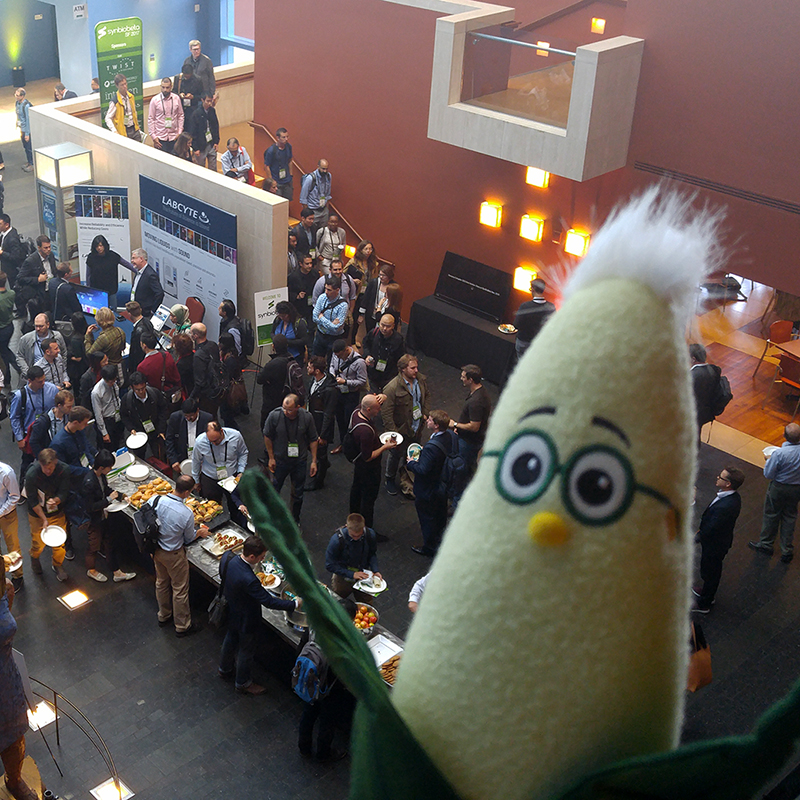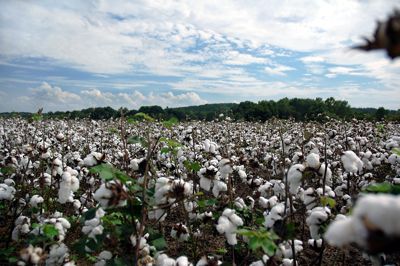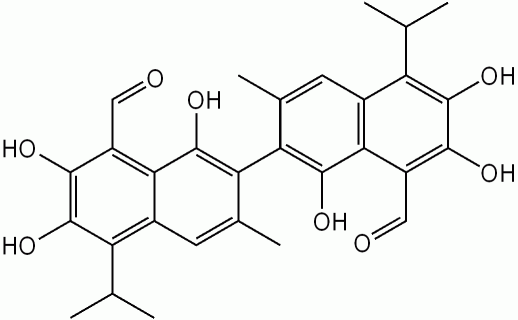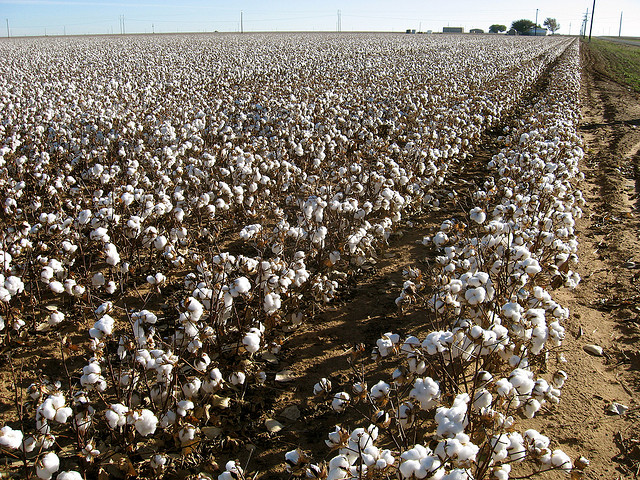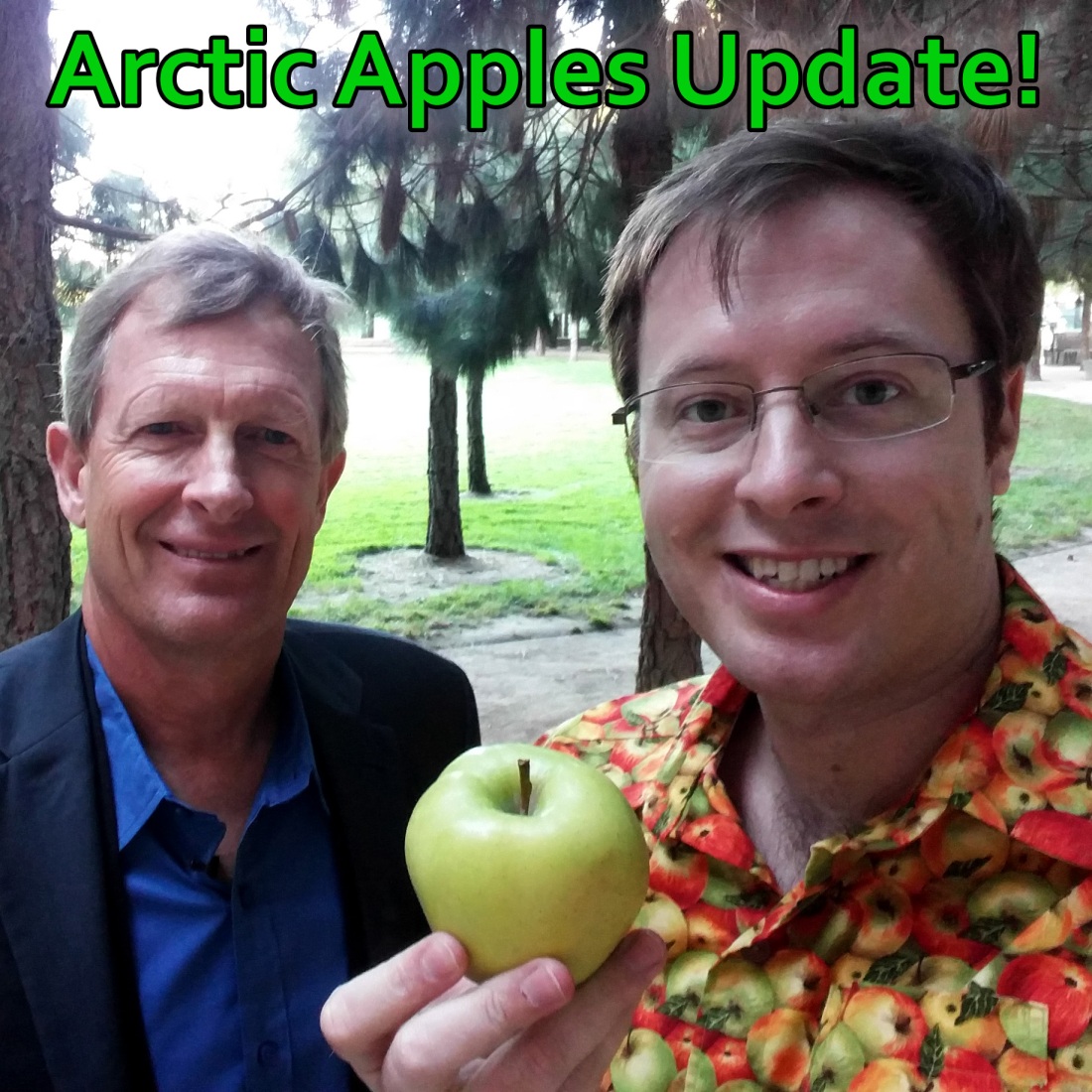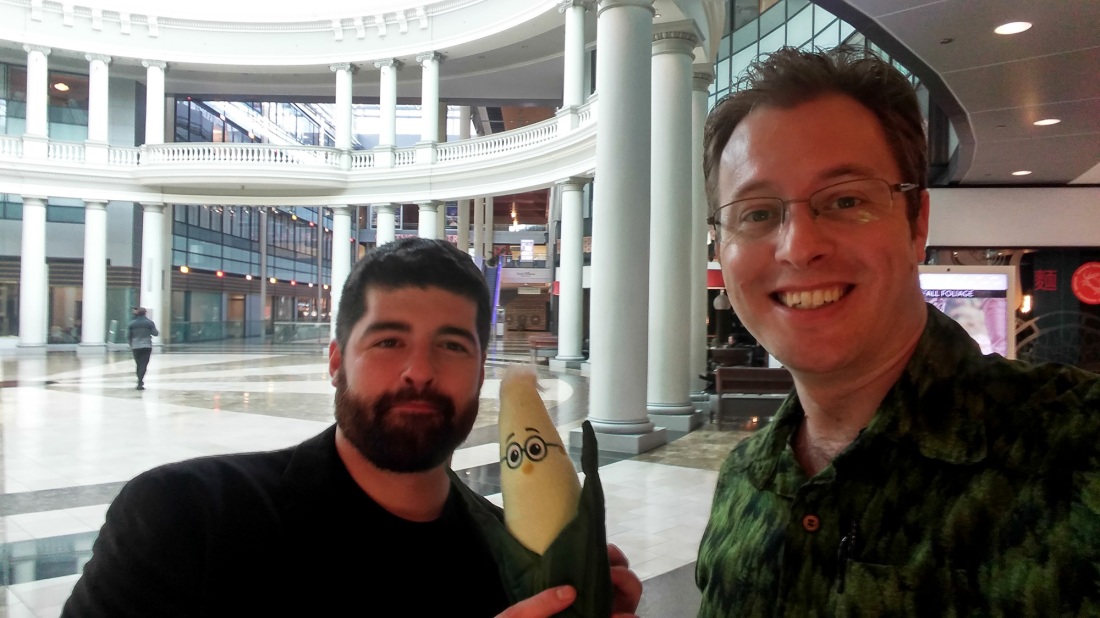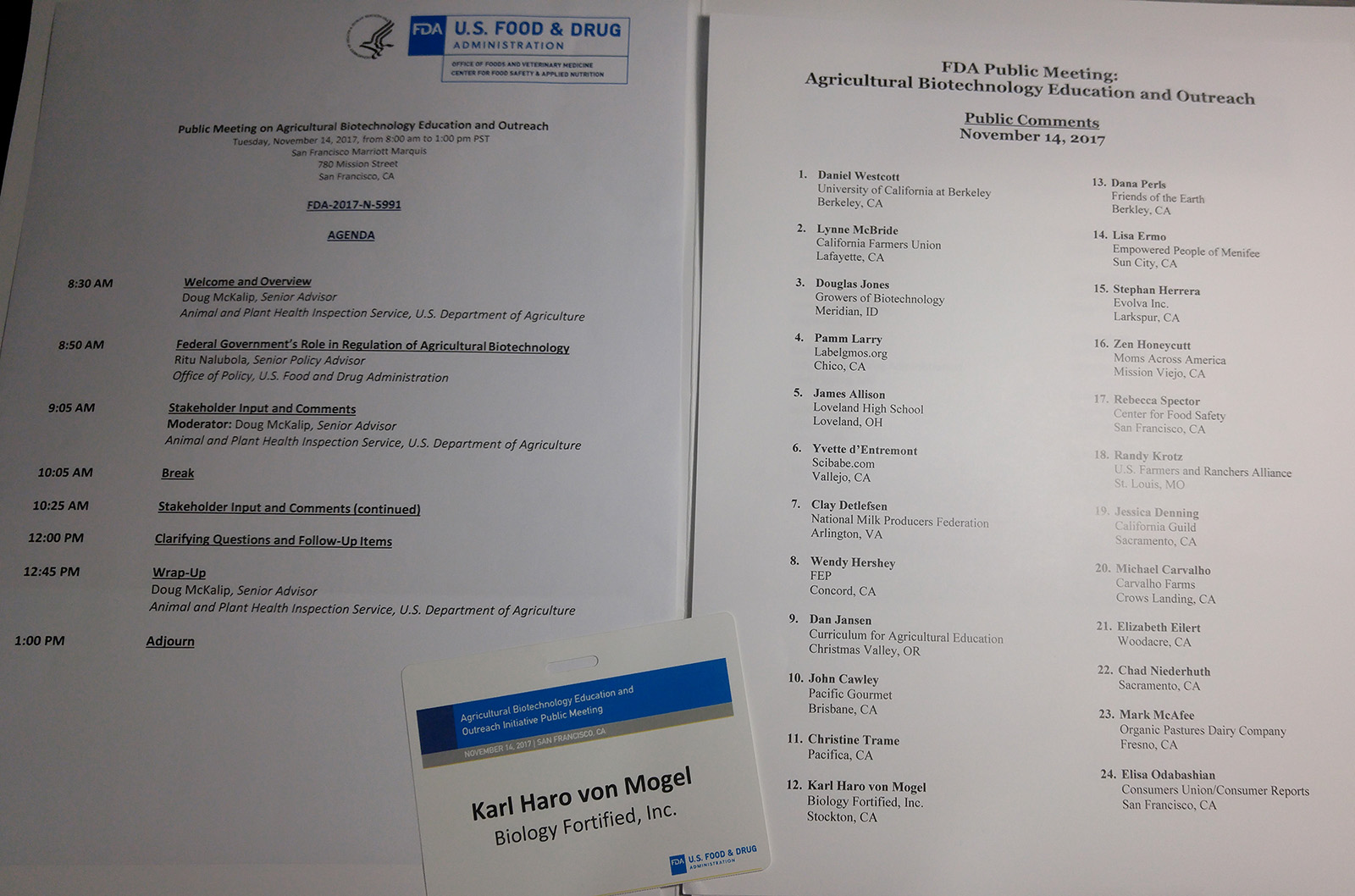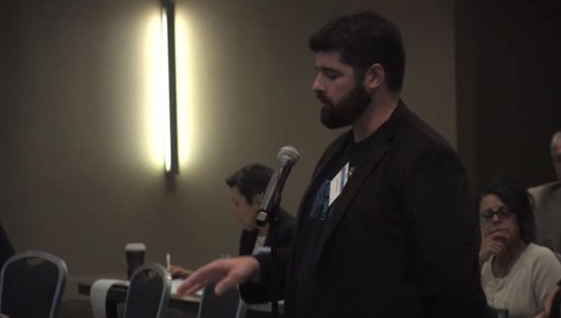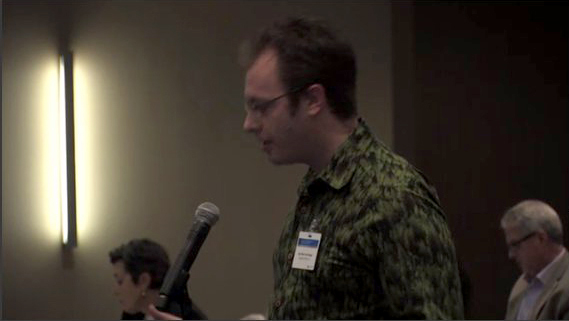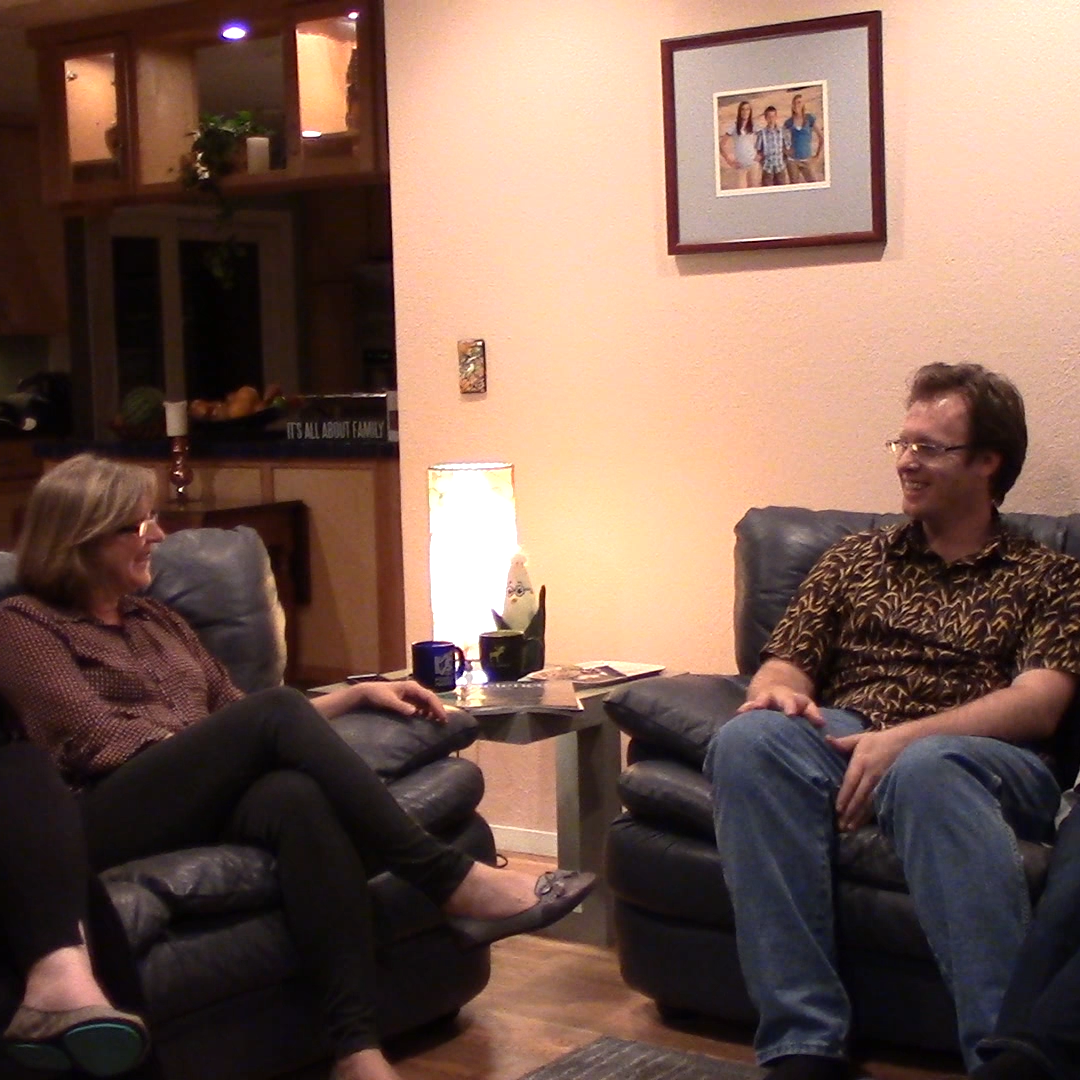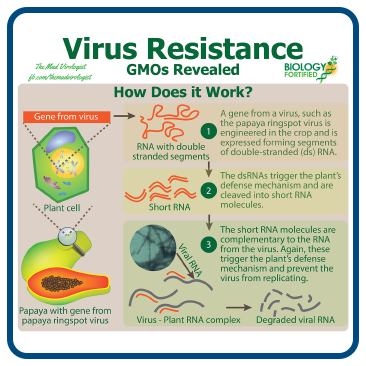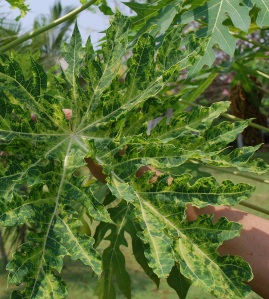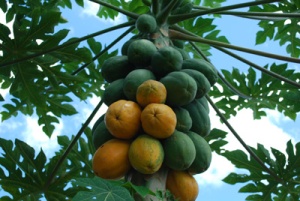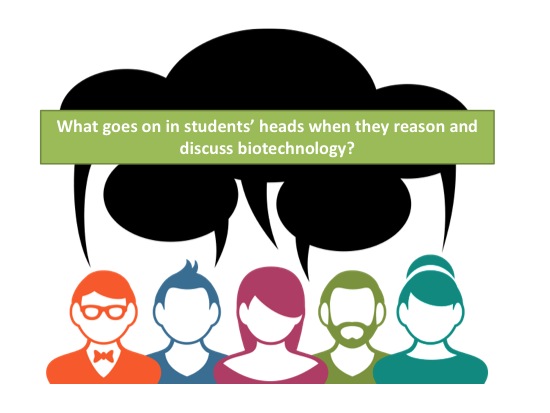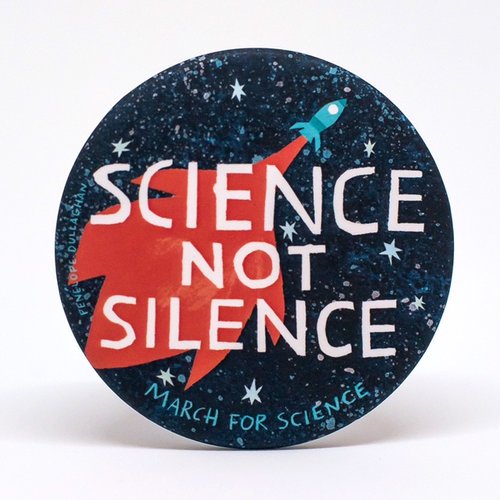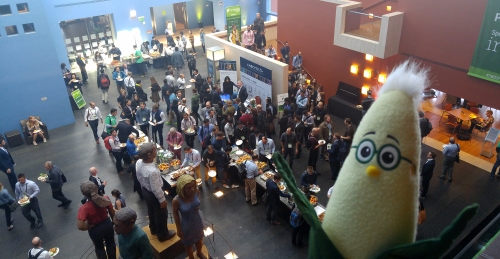
Next week, the SynBioBeta conference for 2018 will commence. This is a synthetic biology conference that brings business entrepreneurs, scientists, programmers and more from around the world to the San Fransisco bay area each year to give presentations, network, and keep up-to-speed on the latest developments in their field. I’ve been to many academic and industry conferences, from the BIO Convention to MOSES Organic, but this one struck me as very unique. Last year, I was invited to attend with complimentary registration, and took that opportunity to interview Neale Carter from Okanagan Specialty Fruits about the latest updates with Arctic Apples (public version / members version). Here I’d like to reflect on how different this conference was from others I’ve been to. Continue reading “SynBioBeta: A different synthesis of a biotech conference”
Tag: Genetic Engineering
Comment TODAY on edible cottonseed deregulation
More than eight years ago, we wrote about a project at Texas A&M University led by Dr. Keerti Rathore to create edible cottonseed. If determined to be safe for food and the environment, this has the potential to make large amounts of protein and calories available that would normally be locked up in the seed. This trait is undergoing deregulation with USDA-APHIS right now, and we encourage our readers to submit comments before the deadline at the end of the day today.
Background
Cotton plants produce a potent defense compound called gossypol, which is toxic to many animals, including humans. Gossypol is produced by special glands throughout the plant, from leaves to seeds, and protects the plants from insect pests and diseases. Some varieties of cotton are glandless and do not produce toxic levels of gossypol, making the seeds and leaves edible. However, because these glandless cotton varieties have lost the protective benefits in their leaves, they are more susceptible to insect damage and are not commonly grown.
Using RNAi, Dr. Rathore’s team at TAMU created a variety they call TAM66274 that “silences” the production of gossypol just in the seeds, producing a plant that defends itself against pests in the leaves, but produces seeds that have ultra-low levels of gossypol in the seeds, making them safe to eat. If applied on a large scale, it could allow humans and many other animals access to the protein contained in cottonseed. According to the data they collected for their application, the composition of the cottonseed was otherwise unchanged, the plants performed the same in the field, and there were very minor changes in the length of the fibers, which they suggest will not be an issue when the trait is bred into “elite” cotton varieties.
The impacts of this trait could be far-reaching. Some estimates suggest that the amount of protein produced in cottonseed worldwide could satisfy the needs of 500 million people. Ruminant animals are able to tolerate some gossypol in their diets, so this trait could create greater flexibility in the animal feed supply. This would turn cottonseed into a valuable co-product of cotton production that could benefit cotton farmers at every scale, producing more food without using more land. Read more about how this trait works and its potential impacts on agriculture in Cotton like Candy.
What APHIS wants to hear from you
Open comment periods for federal regulations are often misunderstood. Some organizations use them to gather signatures (and email addresses) of supporters for their political causes, or set up form letters to mass-send the same talking points over and over to regulators. These actually do nothing more than single letters from one person that say the same thing – because the regulators are looking for public input to identify issues that they should look into during the process – not to count the number of people who think one action or another is a good idea. Back when the FDA was looking for input on biotechnology outreach, there were many opponents and supporters of biotechnology saying “don’t do it” and “do it”, when that was not even a question. It was mandated by Congress, so the question was how should it be done?
Similarly, when the USDA-APHIS is reviewing a genetically engineered crop, they are not going to count how many people say “yes” or “no” to the question of whether to de-regulate (approve) a crop, they want to know what issues related to the economic and environmental impacts they should be aware of when they do the review. Will the crop become a pest on farms? Will it help control pests? Will it benefit the bottom lines of farmers, or reduce the ability of other farmers to farm the way they want to? This is your chance as members of the public, as knowledgeable scientists and science enthusiasts, and as people who think deeply about far-reaching impacts of biotechnological applications, to inform the USDA about data, ideas, and concerns that you have that they can look into when evaluating the crop.
Here it is in their words:
We are advising the public that the Animal and Plant Health Inspection Service has received a petition from Texas A&M AgriLife Research seeking a determination of nonregulated status of cotton designated as event TAM66274, which has been genetically engineered for ultra-low gossypol levels in the cottonseed. The petition has been submitted in accordance with our regulations concerning the introduction of certain genetically engineered organisms and products. We are making the Texas A&M AgriLife Research petition available for review and comment to help us identify potential environmental and interrelated economic issues and impacts that the Animal and Plant Health Inspection Service may determine should be considered in our evaluation of the petition.
Comments are due today at midnight Eastern Time. Since there is not much time left to comment, you can keep your comments brief, but if you have input to give our regulators, please do! There are only 39 comments showing at the time of writing, so you could have an impact. Take a look at the documents prepared by the TAMU research team, and tell the USDA-APHIS what you think. Join me in submitting a public comment on low-gossypol cotton!
We will be following this trait as it moves along, while thinking about how we can improve our own alerts to help mobilize scientists, farmers, and the rest of you to prepare impactful submissions that can help strengthen the regulatory process.
Arctic Apples Update at SynBioBeta
Arctic Apples are coming out in stores this fall. These apples are genetically engineered not to turn brown when sliced or juiced. At the SynBioBeta conference in San Francisco, Karl Haro von Mogel sat down with Neal Carter, President of Okanagan Specialty Fruits, which created the apple. Karl asked him questions about what customers thought about their new apples, where people can find them, the new varieties of Arctic Apples being developed, and if they are working on a non-browning avocado.
Learn more
To find out more about the Arctic Apple, see this Q/A from 2012, and this video interview from 2013. Our Sustaining Members also get access to the Members Exclusive Extended Interview, which is 27 minutes long. In the extended interview you’ll also hear about interactions between Genotype and Environment, licensing of apple varieties, and whether we might also see Arctic Apples in McDonalds!
Go here for more information on Member Premiums:
https://atomic-temporary-156907985.wpcomstaging.com/support/membership/
Arctic Apples Update at SynBioBeta – Members Exclusive Extended Interview
Arctic Apples are coming out in stores this fall. These apples are genetically engineered not to turn brown when sliced or juiced. At the SynBioBeta conference in San Francisco, Karl Haro von Mogel sat down with Neal Carter, President of Okanagan Specialty Fruits, which created the apple. Karl asked him questions about what customers thought about their new apples, where people can find them, the new varieties of Arctic Apples being developed, and if they are working on a non-browning avocado. In this extended interview you’ll also hear about interactions between Genotype and Environment, licensing of apple varieties, and whether we might also see Arctic Apples in McDonalds!
This video contains the full 27-minute interview, available only for our Sustaining Members.
Thank you for being a Sustaining Member! Go here for more information on Member Premiums:
https://atomic-temporary-156907985.wpcomstaging.com/support/membership/
To find out more about the Arctic Apple, see this Q/A from 2012, and this video interview from 2013.
Making a difference at the FDA Biotech meeting
On Tuesday, I attended the FDA Biotech Education and Outreach public meeting in San Francisco, and here is my experience participating in this public event. I was happy to be able to make a comment on behalf of Biology Fortified, and the feedback I received was very helpful and gave us guidance on what the FDA wants to know more about. There were some new and fresh voices who provided useful information, as well as familiar faces from groups opposed to biotechnology who provided some comments worth paying attention to, as well as clearly false information worth responding to. And of course, there were a few characters who went beyond misunderstanding the purpose of the meeting and instead promoted their products, conspiracy theories, and the concerns people expressed showed the FDA representatives how deeply problematic this topic has become in the last couple decades.
Getting there
First, it is very difficult for anyone to be able to attend and participate in such meetings. Held on weekdays, and downtown in major cities, the room that could have fit a couple hundred people had closer to 30. People have work, there is the long commute through heavy traffic (especially to get to San Francisco), various costs involved, and also takes preparation. I was joined by Chad Niederhuth, who drove all the way from Sacramento that morning to give a comment, and Zen Honeycutt and Yvette d’Entremont had signed up but did not attend. Anyone who manages to make it to these meetings is a rare exception, and it skews the kinds of comments and perspectives that our government can get. Nevertheless, it is an important way for our government to hear from its citizenry, and I was happy to see many diverse voices in attendance, including those with which I may disagree.
Myself, it was quite a squeeze to be a part of this. I spent the weekend with family in Los Angeles, and drove home Monday, only to eat dinner and immediately continue to San Francisco. Parking in the east bay, I took BART into the city and stayed in the cheapest hotel I could find, a couple blocks away from the event location. I was only able to do this because of our sustaining members, because unlike some of the organizations on either side of the biotechnology debate, we do not have the deep pockets of industry and ideological organizations backing us. The more support we can get, the more you will see us being able to take the time to get involved!
Voices new and old
The people who signed up to give oral comments were an interesting and diverse group, with some new voices who added some fresh perspectives. The first comment was made by Daniel Westcott, a graduate student at UC Berkeley, who talked about their science communication efforts in the CLEAR program, and spoke about false dichotomies between areas of agriculture like with biotech and organic. Lynn McBride, from the California Farmer’s Union recommended reaching out to farmers and talking about impacts on the farm. James Allison is a high school teacher who came all the way from Loveland, Ohio, and he shared his experiences developing curricula for students in high schools and suggested that the FDA consider that as one route for their communication efforts.
Stephan Herrera, from Evolva, Inc., recommended creating materials to complement food labeling laws so that the public does not perceive that biotech-derived foods have safety issues, create “Perception vs Reality” documents, and hold challenges for students to create their own videos about food facts. He also emphasized the need for the FDA to understand and employ Search Engine Optimization (SEO) so that their pages can be found by the public. Chad Niederhuth also added that the FDA should base their science communication efforts on science-based recommendations so that they know that they will have an impact.
There were some familiar organizations that campaign against biotechnology who were in attendance and delivered comments as well. Dana Perls from Friends of the Earth gave many critical comments about genetically engineered crops, and directly attacked the scientific consensus on the safety of consuming the genetically engineered crops that are on the market, calling it a “false generalization.” Lisa Ermo, representing Moms Across America, claimed that genetically engineered foods are lower in nutrients (they are not), but mainly spoke about glyphosate in the herbicide Roundup.
There was one familiar voice who signed up to speak in-person who was a welcome addition to the public comments. Peggy Lemaux, a professor at UC Berkeley, was the last person to comment. She told the story of the ice-minus bacteria and how lack of public engagement contributed to poor perceptions, along with researchers wearing suits that “looked like a toxic waste cleanup.” She stressed the importance of university extension programs, and surveying the public’s questions and concerns to figure out what to communicate to them about the technology.
Lawyer Lawyer
The comments from the Center for Food Safety representative, Rebecca Spector, deserve much more attention. Read like they were drafted by lawyers, they also hint at the various ways that the anti-GMO law firm may work to attack and undermine any outreach program from the FDA. For instance, Spector suggested that the “FDA should not communicate anything that is contradicted by agency statements.” As an example, she cited an oft-repeated claim that the USDA said that DroughtGard, a Monsanto GE corn variety engineered for drought tolerance was found by the USDA to be “inferior to conventional breeding” and that it wasn’t any more drought tolerant than other varieties of corn. This is based on a USDA regulatory document (Finding of No Significant Impact, page 33) that said that there are other drought-tolerant corn varieties in different genetic backgrounds that have similar tolerance to drought. It is widely misinterpreted to mean that the drought tolerance doesn’t work, or in this case, claim that it is inferior, but the USDA did not conclude that at all. What is important to remember is that this is a single gene that can confer drought tolerance in almost any genetic background, and can be used in breeding to achieve that trait irrespective of the other traits in the variety. It is a useful advancement, and it protects some of the yield during moderate drought. The Center for Food Safety is misrepresenting the USDA’s comments.
To put it another way, let’s say you engineered a granny smith apple to have a red skin. There are other apples with other genetic backgrounds (other flavors, shapes, sizes, etc) that also have red skin. But this apple is now red with a previously non-red genetic background of the granny smith. The USDA deregulates this red-skinned granny smith and mentions “It is prudent to note that red apple skin is also present in other genetic backgrounds and this new variety does not exceed the redness found in these other varieties.” The Center for Food Safety then reports that genetic engineering is inferior to breeding, that the USDA says it doesn’t work, and the FDA should not be allowed to say that the genetically engineered red-skinned apple is in fact… red.
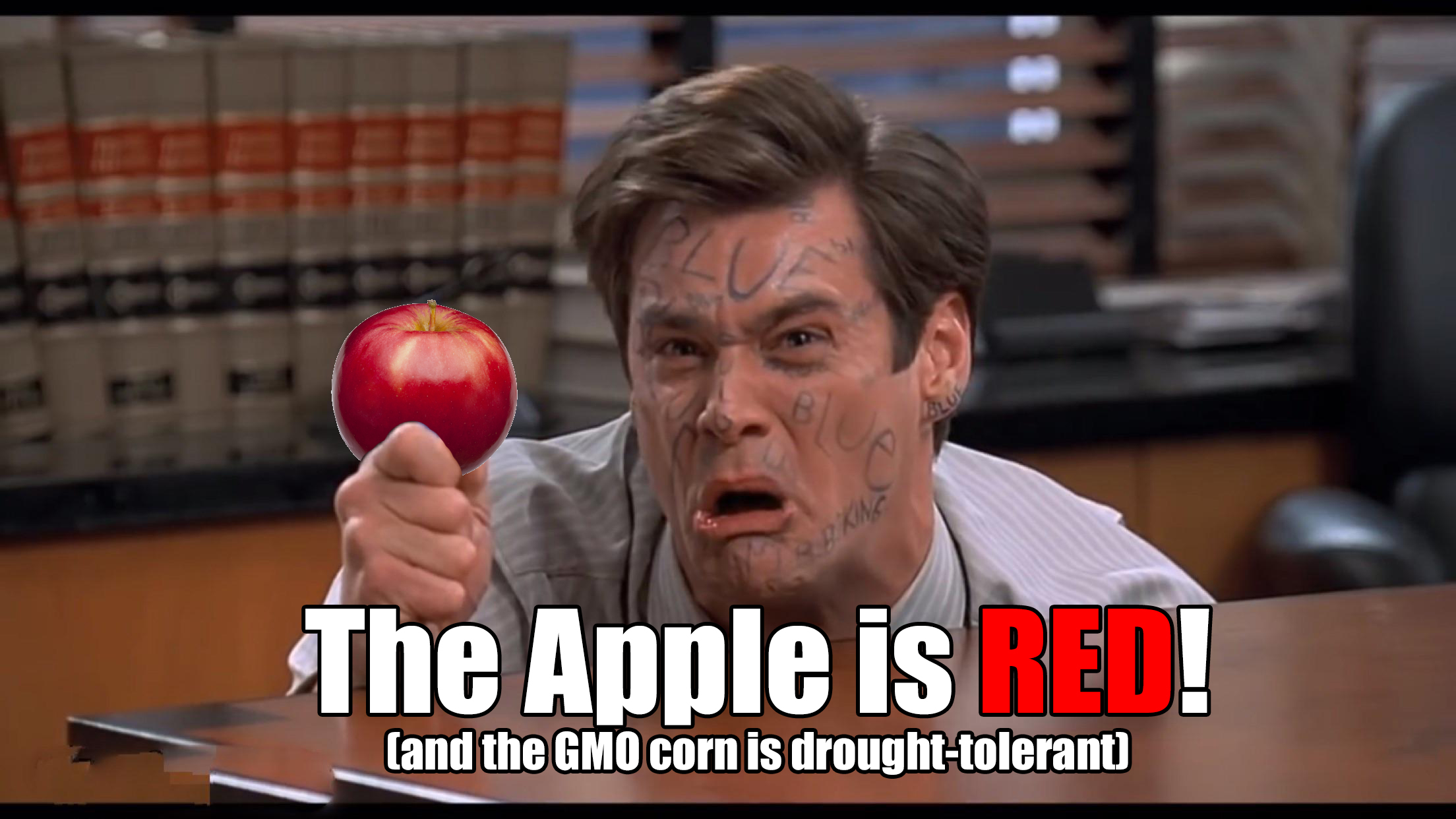
Other statements by Spector were worse. She misrepresented the National Academy of Sciences report on GE crops that was published last year, saying that they found that GE crops did not increase yields. The report touched on yield in several places, and stated that they could not conclude that GE crops had increased the rate at which yields were going up, but did in fact state that they had contributed to yield gain. Even Doug Gurian-Sherman, who has worked for CFS, estimated that GE insect-resistant traits had increased yield. Furthermore, Spector said that the industry “failed to produce a commercialized GE crop with enhanced nutritional content.” The Center for Food Safety spends its time suing to stop the approval of every genetically engineered crop that it can, is now complaining that none have come to market? Apparently they missed the approval of high-oleic Plenish soybeans by DuPont Pioneer (see our interview with Susan Knowlton here) and omega-3 fatty acid producing soybeans by Monsanto. I’m sure they just forgot about them.
Rebecca Spector said that the public “should not be given information that is false and misleading” and I wholeheartedly agree.
Consumers Union sides with general safety, argues falsehoods
Elisa Odabashian, representing the Consumer’s Union spoke against “misleading” information about genetically engineered foods. She repeated the same claims about the NAS report and yields, and claimed that GE crops “vastly” increased herbicide use while decreasing insecticide use. She said that Roundup use “increased more than 15 times” but neglected to mention reductions of other herbicides that it replaced, a very common and intentionally misleading statement about pesticide use. Odabashian said that the FDA should only communicate “settled science.” The use of this term seemed very odd, as it has a very specific meaning in political contexts, widely used by opponents of climate change science to undermine its acceptance. She claimed that Golden Rice has stunted growth, citing a poorly-researched blog post that looked at the wrong transgenic event – one that was discontinued 3 years ago. The current Golden Rice variety has already begun the approval process in the Philippines.
Odabasian made some good comments that should be carefully understood by everyone. She said that there is no strong evidence that the GE crops on the market pose safety hazards, although the technology carries some risk. She distanced the Consumer’s Union from the many unsubstantiated claims that genetic engineering is responsible for, such as autism, gluten intolerance, etc. “These claims have been poorly documented, if at all.” These are statements that I agree with. However, the Consumer’s Union has become a source for many of these widespread, unsubstantiated claims. Michael Hansen, a chief scientist working for the organization, has claimed that GE apples might require more pesticides (they don’t), Golden Rice could cause birth defects (it wouldn’t), and a whole host of other claims. I applaud Elisa Odobashian for standing against widespread myths, and daresay that it would be advisable for her organization to take a deeper look into its own role in advancing claims that they are now trying to distance themselves from.
Comments and feedback
I’ll now turn to my own comments delivered during the meeting. As I mentioned previously, Biology Fortified is submitting written comments to the FDA docket to contribute to the information that the FDA has at hand when they put this program together. We could have just submitted them electronically, but I had never participated in this kind of process before. I modified our comments to read them orally, signed up, and hardly slept the night before. I was nervous, but quickly I read our comments, addressing the gaps in public understanding, the need for addressing the issue of safety, farming contexts, and to better explain the FDA’s role in regulating the technology in what’s called the Coordinated Framework. I pointed out that the public needs an independent source for information about nutritionally altered foods and that some FAQ about common questions would be helpful, but advised against addressing every specific claim. I may have spurred many of the anti-consensus claims made by others, but even the Consumer’s Union agreed that evidence of any harm is weak if it even exists.
The FDA also wanted to know where people were getting their information, and how they should go about communicating to the public. Unfortunately, the most easily available information is factually inaccurate, but the upside is that the issue is not deeply polarized. I conveyed a lot of our ideas on how to carry out the outreach, following a “train the trainers” model and using existing networks to get out their message efficiently, rather than reinventing the wheel. I also talked about designing it for social media, and it was these comments that they were particularly interested in. I answered a couple questions about how to go about doing this, who to network with, and we shared a light-hearted moment about how unpredictable and yet so full of potential memes can be.
As a result of the feedback I received, and more ideas that came from the meeting, we’re adding more to our comments to submit them in written form before the deadline. I talked to several of the FDA representatives afterward and they were happy to have our contributions, along with everyone else’s. I’m very glad I went and it was a very valuable experience.
On characters and concerns
The meeting had a few outlandish characters, and its share of genuine concerns expressed about genetically engineered crops. One such character was Mark McAfee, the owner of Organic Pastures Dairy, who quite passionately talked about his personal integrity at length, mounted a defense of raw milk, and attacked the FDA for making his business more difficult. Organic Pastures has been linked to multiple food-borne illness outbreaks such as E. coli, Salmonella, and Campylobacter, some of which have been traced to their products. It got so bad that they started printing labels on their milk bottles talking about their customers’ immune systems as reasons why they could get sick. McAfee spent very little time talking about the issue of the day, but did cap his presentation with saying that the people at the FDA who had been “bought out” had to be rounded up and arrested!
Pamm Larry, from GMO Free California, gave a very disorganized rant that covered everything except her anti-vaccine views. “Why would any critical thinker trust the data?” she said. She complained about why it is considered unethical to demand human studies of GMOs (without any valid hypothesis to test). At the end, she argued that they should instead spend their funds on a scientific study and get Pamela Ronald, Kevin Folta, and Gilles-Eric Seralini in the same room to hammer it out. Her proposal sounded great until she said that the doors should be locked, and 24 hour cameras and bodyguards were necessary! (For whom?) Cooperation across the divide has been repeatedly proposed on our end, and rejected every time. Seralini withdrew from followups to his infamous rat tumor study, so maybe they should have locked the door? Our door is still open.
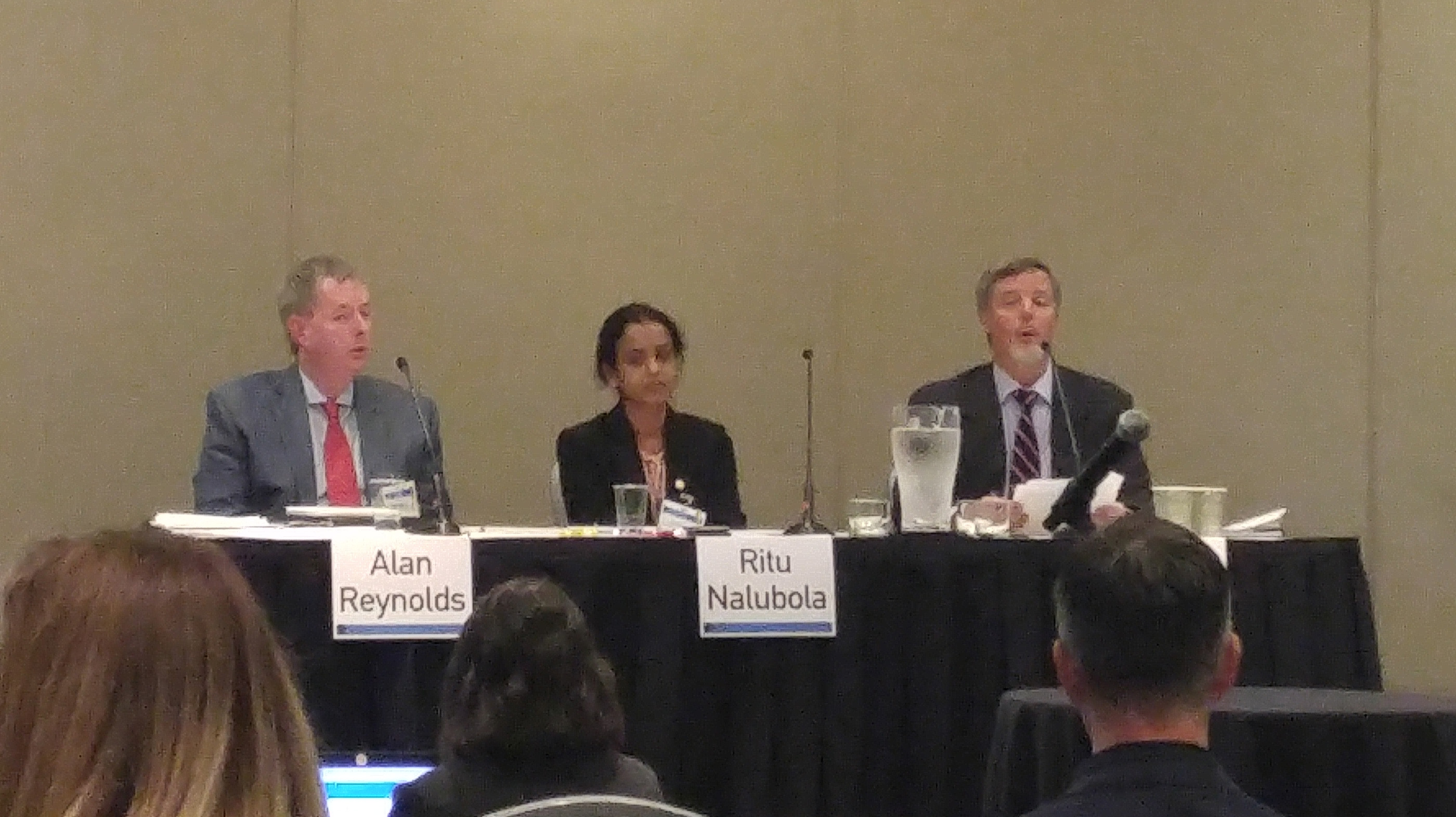
There were many people who expressed general concerns about biotechnology, and the trustworthiness of the companies and the FDA. They didn’t come to speak to the questions the FDA was posing, but to instead show their opposition to the measure, and their desire for a more approachable FDA with a clearer website. Even Mark McAfee got back up and said he wanted a “mommy-friendly FDA.” They wanted to be able to talk to their regulators, and break down the wall of misunderstanding. They wanted the FDA to know they had concerns about their health, and those of their families. The FDA representatives took some time to talk about their own motivations and concerns about their children and their own health. It seemed at times that even those who were deeply suspicious of the FDA were really elated just to be able to meet them face-to-face and understand that everyone in the room is human and wants to be able to connect and understand each other. Perhaps some of the same people who came to the meeting afraid of biotechnology may someday be thankful of future efforts made possible by how they expressed their concerns that day?
Alan Reynolds, one of the three FDA representatives on the stage, said “the most important word today was TRUST.”
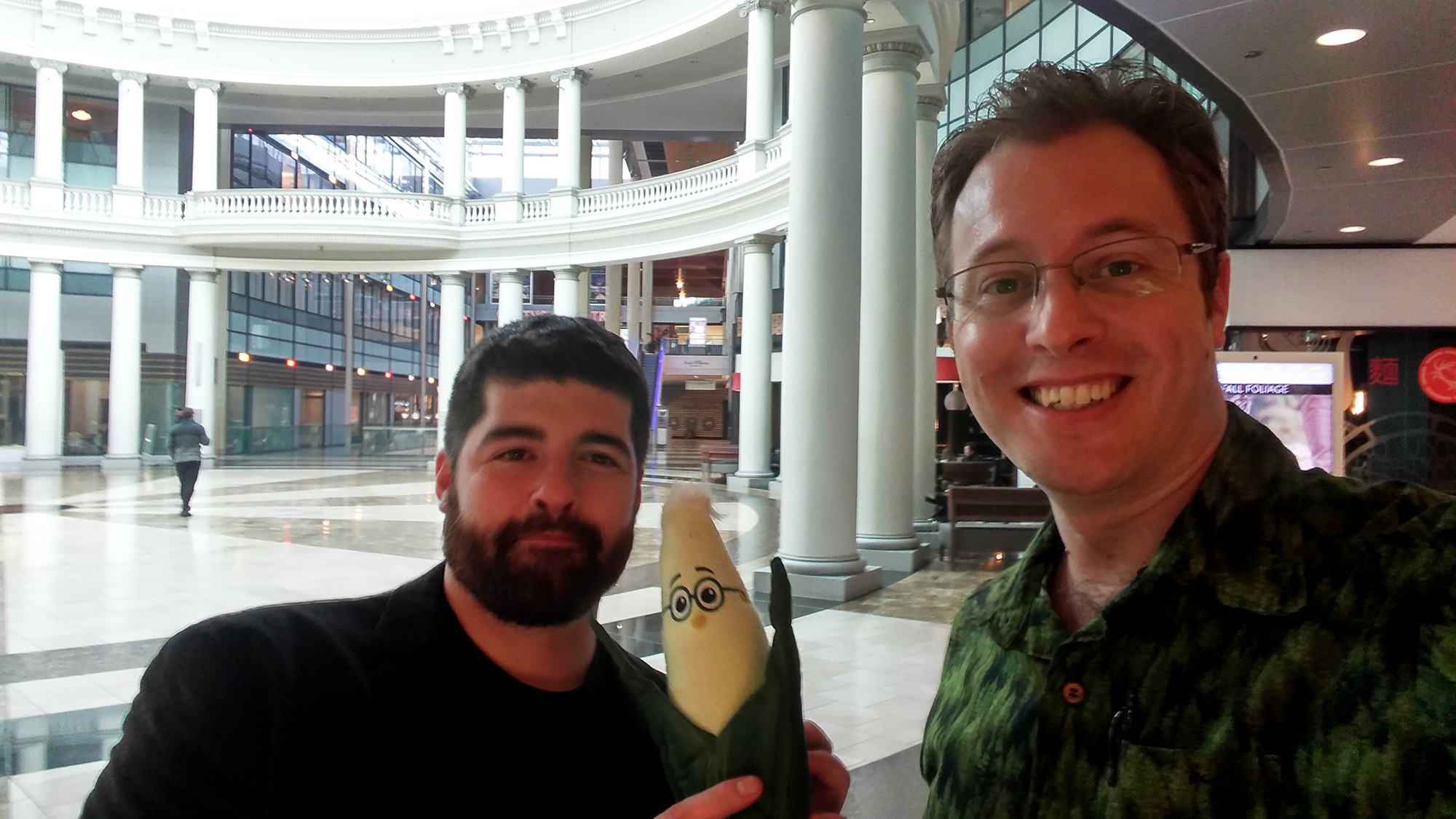
Last day to submit comments!
The FDA docket is about to close, at the end of the day on Friday the 17th – today. If you want to have an impact on this education and outreach initiative, I strongly urge you to answer the FDA’s questions and submit them right now. If you don’t then their only guidance will be what I have described here, their previous meeting in Charlotte NC, and what you see that has already been submitted. Add your voice now – you have until midnight Eastern Standard Time.
Biology Fortified completed comment:
GM Camelina can provide omega-3s for fish
Written by Rebecca Nesbit
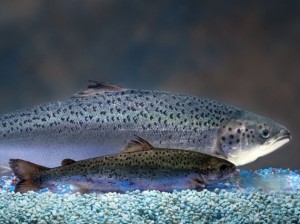
Biotechnology in the fish farming industry hit the headlines in 2017 when a fast-growing salmon became the first GM animal to reach the market. In Europe, however, new developments in biotech’s potential for aquaculture went largely un-reported. Rather than focusing on the fish, British scientists are making progress towards creating fish food from a transgenic plant. For almost two decades, scientists from Rothamsted Research and their collaborators have been working towards providing oils for farmed fish from one of Europe’s oldest oilseed cropsLcamelina. The latest results bring them a step closer to realizing their vision.
Why focus on fish feed? To understand that we must think about where our fish and their nutrients come from.
The current problems with meeting our demand for fish
Over half of the fish we consume comes from farms, and aquaculture uses around 80% of the fish oil harvested annually from the sea. More fish goes into the system than comes out, which means that much of the fish caught from the wild goes to feeding farmed fish. Growing demand for omega-3 LC-PUFAs, particularly from aquaculture, has placed substantial pressure on the wild fisheries which supply much of this fish oil.
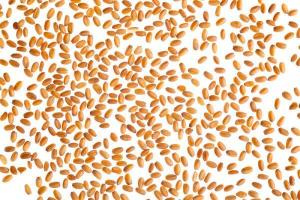
The root of the problem is that that fish oils aren’t produced by fish. Instead fish acquire them from microalgae, which aren’t available to caged fish in farms. We don’t currently have financially-viable technology to produce algae on a large scale, so farmed fish are fed oil and meal made from fish caught from the oceans. In this way, the fatty acids consumed by the smallest fish accumulate all the way up through the food web.
Vegetable oil can be used as an alternative to fish oil in feed, but this changes the nutritional value of the fish people eat. Given that fish can’t make their own fish oils, they can only accumulate these oils if they consume them as part of their diet. Now that farmed fish have more vegetable oil in their diets, they are no longer providing consumers with the same level of omega-3 and the associated health benefits.
Producing the appropriate oils from plants has the potential to ensure that farmed fish bring their full benefits for human health, whilst simultaneously reducing pressure on wild fish stocks.
Promising results from 2017
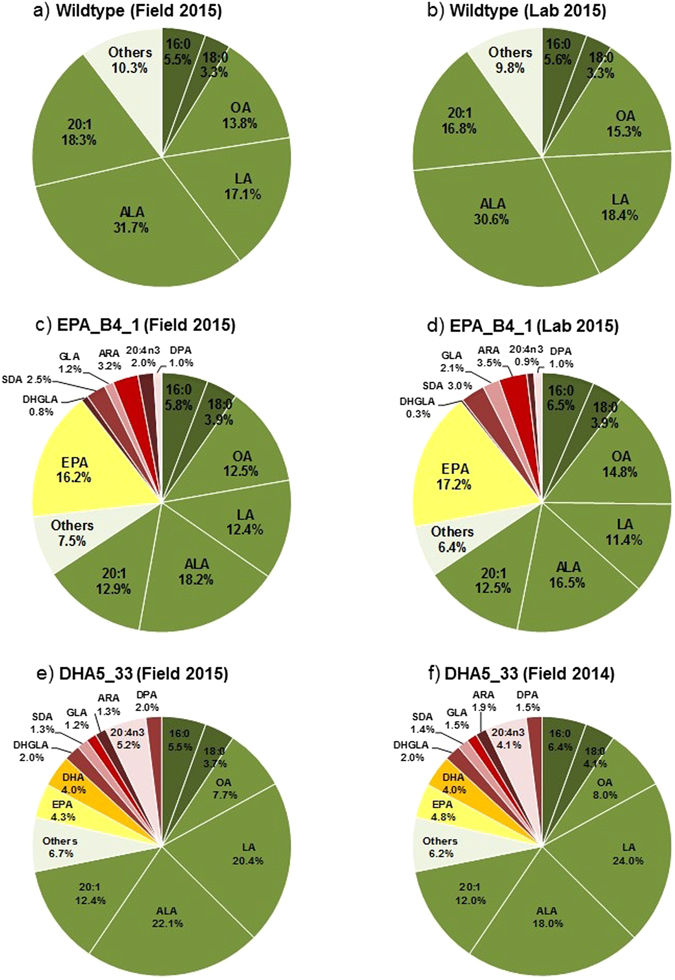
A new paper in Scientific Reports shows that their plants have the potential to yield oils in the field, and results published in the journal PLOS ONE showed that these oils are suitable food for salmon. The project, led by Professor Johnathan Napier, uses Camelina sativa (false flax), a distant relative of oilseed rape. Camelina is naturally high in short-chain omega-3, but it’s long-chain omega-3 that is important for fish food. To change the profile of oils in the seed, the team has introduced synthetic DNA sequences into the camelina genome. The introduced genes are similar to those found in marine microbes, and code for enzymes in the biochemical pathway which produces long-chain omega-3 polyunsaturated fatty acids (LC-PUFAs).
The oil can be extracted from the seed and fed to fish, and that is exactly what happened in the feeding trial reported in PLOS ONE. The newly-published data show results from a 2015 field trial of GM camelina, and confirm positive findings from 2014.
Firstly, results from both years show that the transgenic plants perform well in the field. The studies went beyond agronomic performance, as they also examined the composition, or profile, of the oil produced by the plant.
The profile of seed oil has also been improved relative to earlier varieties of transgenic camelina. Not only were the scientists looking to increase the concentration of desirable fatty acids, they were also keen to reduce the production of some of camelina’s natural oils. Omega-6 fatty acids are only present in low levels in marine organisms, so the latest varieties have been engineered to produce smaller quantities.
Salmon feeding trials have also seen positive results, and oil from GM camelina was an effective substitute for fish oil in feeds, supporting growth without compromising fish health. The fish accumulated fatty acids exactly as they would when fed oil from fish, creating a fish with the desired health benefits for consumers.
Trials on sea bream have also indicated that GM-derived oils could replace fish oils in their diets.
The future of camelina
The results published in 2017 indicate that oils from transgenic plants offer the opportunity to increase the levels of omega-3 LC-PUFAs in farmed fish to levels found a decade ago. Further development work is now taking place to make this a reality on a large scale.
The next steps for the project is to select the best camelina lines – i.e. those producing the highest levels of omega-3 fish oils. These plants will be used in larger field trials to demonstrate that they perform as well in the field as they do in the glasshouse.
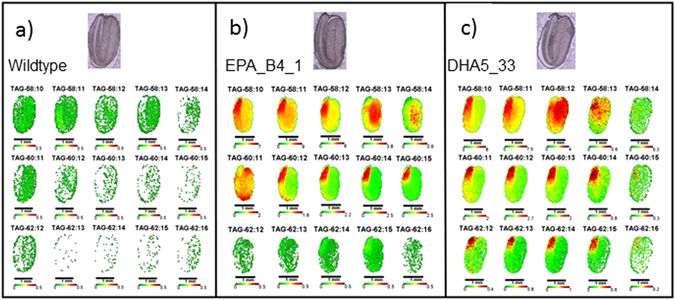
The work will then need to move from the research phase to development and commercialization. As well as planning how to make the crop available on a commercial scale, an essential step will be seeking regulatory approval. Although the research has been done in the UK, the status of the EU regulatory system means that the team will be applying for approvals outside of Europe.
Issues to be addressed before the plants are suitable for regulatory approval include freedom-to-operate (ensuring that no patents would be infringed if the crop is commercialized), and appropriate farm management. Camelina is predominantly self-pollinated but is visited by insects, so during the trials scientists addressed concerns from local beekeepers by covering the flowering crop with a fine mesh net to prevent bees from transporting GM pollen back to their hives. Such measures wouldn’t be feasible if the crop was grown on a commercial scale, but the team is considering the farm management practices which would be needed to prevent gene flow. Thankfully, camelina doesn’t cross pollinate with oilseed rape or other Brassica species, making large-scale planting more feasible without risking cross-pollination of other crops. In the end, to goal is to make aquaculture more environmentally sustainable while maintaining the healthy properties of the fish that we eat.
For updates on the project and more background reading, please visit the Rothamsted website. I also cover the topic in my book Is that Fish in Your Tomato?
Written by Guest Expert
Rebecca Nesbit is author of the popular science book ‘Is that Fish in your Tomato?’ which explores the fact and fiction of GM foods. She studied butterfly migration for her PhD, then worked for a start-up company training honeybees to detect explosives. She now works in science communication and her projects have ranged from a citizen science flying ant survey to visiting universities around the world with Nobel Laureates. In her spare time she writes fiction – she has published a novel, and many short stories.
Glyphosate, breast milk, science and conflict
Last year while driving across the country, I made a slight detour northward to visit the city of Moscow, Idaho. I met up with Professor Shelley McGuire at Washington State University and two other members of her team, Kimberly Lackey and Bill Price, who together published the study that showed that breast milk did not contain glyphosate, the active ingredient in Roundup. It was a simple and scientifically straight-forward series of experiments, and was confirmed by a separate research team in Germany. Scientifically this was uncontroversial, but Dr. McGuire’s team became embroiled in controversy because some organizations found it inconvenient for their political campaigns against the chemical.
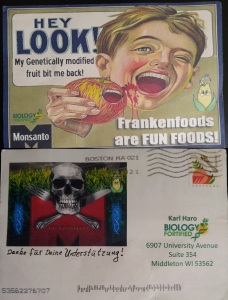
Organizations like Moms Across America and Sustainable Pulse attacked her reputation and her research, while USRTK submitted records requests for all her correspondence. This study was so important that they gave her both barrels. Meanwhile, she was open, patient, and wanted to answer people’s questions. Followers of these organizations even got upset when their moderators deleted her civil answers to their questions. It became apparent that they didn’t even want their followers to learn from this study.
At the height of it all, Shelley received a harassing postcard. With a combination of bad photoshop skills and maximum creepiness, someone sought to harass her by snail mail. We know of only one other scientist who has received such an illuminating treatise on productive dialog – me*. The Boston postal artisan even wrote “Thanks for the support” in German, giving it an original charm it desperately needed. When people lash out at scientists with such hateful, tasteless, confused artifacts, it means that they are revealing parts of the universe that are dangerous to their identity.
In Moscow, we sat down and had a great chat about the study, its methods, interpretations, funding, and public reactions. I also described my visit to Covance in Madison, WI, which is the company that did some of the glyphosate detection experiments. I learned that conflicts of interest are not always what they seem. Dr. McGuire’s research was thorough, confirmed, and influential for public policy – everything that the organizations who attacked her were not. This contrast was also explained in Food Evolution (see my review here), which you should see if you haven’t yet done so.
In all these serious considerations of glyphosate, breast milk, science and conflict, we found some good opportunities to laugh. Give it a watch, and tell us what you think! After all, no subject is too heavy to grab a refreshing drink, sink into a comfy couch and have a nice evening chat.
Reference:
McGuire, MK et al. Glyphosate and aminomethylphosphonic acid are not detectable in human milk. Am J Clin Nutr. 2016 May;103(5):1285-90. doi: 10.3945/ajcn.115.126854
http://ajcn.nutrition.org/content/early/2016/03/30/ajcn.115.126854.abstract
“Our data provide evidence that glyphosate and AMPA are not detectable in milk produced by women living in this region of the US Pacific Northwest. By extension, our results therefore suggest that dietary glyphosate exposure is not a health concern for breastfed infants.”
*After publishing this article, several other individuals have come forward and reported to have also received a version of the skull-and-crossbones postcard. Mary Mangan published a Storify cataloguing them as they come forward.
How virus resistance works in GMOs
Written by Alma Laney
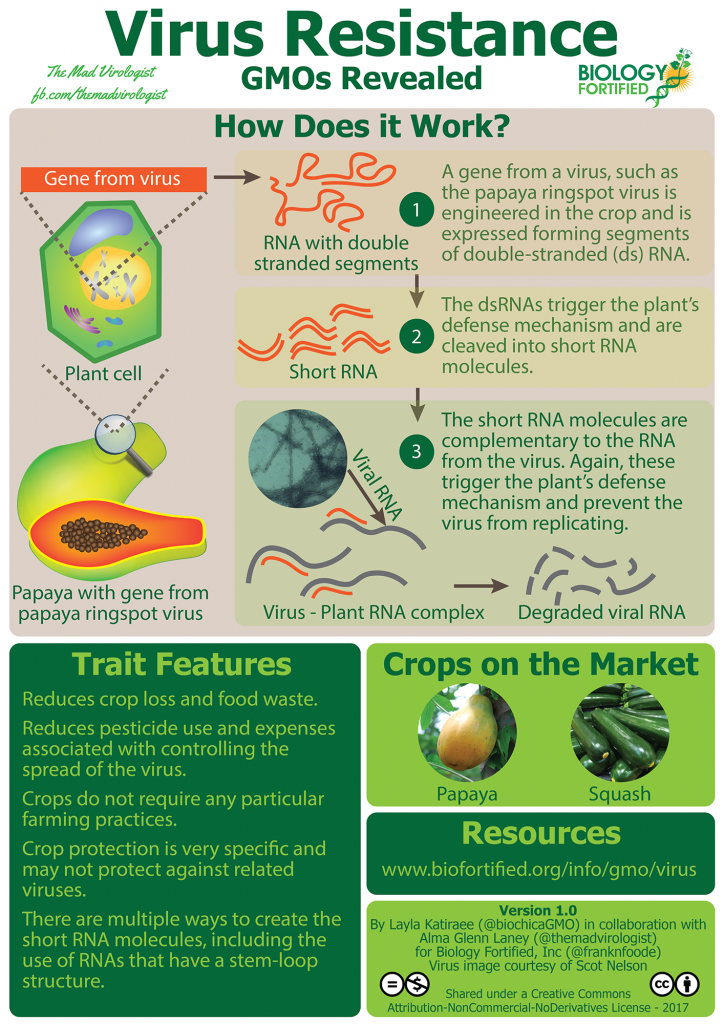
I’m Alma Laney from The Mad Virologist, and I work with plant viruses and the insects that help them spread. I’m happy to announce that Biology Fortified just published a new infographic that I helped develop with Layla Katiraee and the rest of the team here at Biology Fortified to help explain how virus resistance is created in genetically engineered crops.
The GMOs Revealed infographic on Virus Resistance distills a lot of information about how to engineer this trait into plants, with papayas and squash as the current examples on the market. There is really a lot more to this issue than these two examples, so I wanted to give a detailed overview explaining the challenges that farmers face with viral plant diseases, methods of control, and approaches to engineering resistance. Go to the infographic page for the short version, but if that’s not enough to ‘inoculate’ your curious mind, read on!
Introduction
Plant viruses can be serious pathogens in crops as they can cause anywhere from minor losses to a total loss. Viruses can infect crops in a number of ways ranging from being transmitted by contaminated tools, seed and pollen infections, infection of tubers or other vegetatively propagated material, and by arthropod vectors1 (what mites and insects are collectively known as). Most plant viruses are transmitted to crops via arthropod vectors. Plant viruses are of concern to farmers because once they get into a crop, all you can do is try and prevent their spread. Because of this, control strategies focus on preventing the introduction and spread of these viruses.
Control of plant viruses
There are several strategies that farmers use to prevent and control viral infections:
- Use certified seed or plants, which have been tested for known pathogens. Lots containing pathogens are rejected by the company.
- Control weeds around the fields as weeds can harbor both viruses and their vectors, serving as a source of inoculum for the field.
- Limit the spread of soil and the use of dirty implements. Some plant viruses can be carried by infested soil and contaminated implements can transfer the virus to healthy plants. There are many disinfectants that can be used including dilute bleach and milk solutions.
- Use seed treatments and/or spraying insecticides on the crop. Since most plant viruses are transmitted by arthropod vectors, this can be an effective strategy but it does not work in cases where the viruses are transmitted quickly (in non-persistent or semi-persistent transmission; see Table 1).
- A control strategy that isn’t always effective is to use a mild strain of a virus that is inoculated onto a plant. The mild strain can induce resistance to more severe strains, but this is problematic as mixed infections with other viruses can cause severe disease, the mild strain could become more severe, the mild strain would still cause economic losses, or the mild strain just may not work. This strategy is called cross protection.
- Once a virus is in a field, farmers can take action by roguing symptomatic plants (removal of infected plants followed by destroying them). This can be a costly measure and is used in cases where the type of virus can be transmitted quickly.
Table 1: The types of virus transmission2 detailing how long it takes to acquire a virus, how long it takes before the virus can be transmitted, and an example of each.
| Transmission type | Virus acquisition | Virus transmission | Example |
| Non-persistent | As little as a few seconds | A few minutes | Papaya ringspot potyvirus |
| Semi-persistent | Several minutes | Minutes to hours | Cauliflower mosaic caulimovirus |
| Circulative, non-propagative | Minutes to hours | Hours to days | Barley yellow dwarf luteovirus-PAV |
| Circulative, propagative | Minutes to hours | Up to a few weeks | Tomato spotted wilt tospovirus |
However, one of the best strategies is to engineer resistance to plant viruses. There are several examples of plant virus resistance genes that can be found in the germplasm (a collection of seed and/or plant tissue reflecting a variety of genotypes). However, for some crops, there are no known resistance genes or if they exist, they are found in wild relatives and attempts to introgress (move a trait into a crop plant by conventional breeding) the genes have not been successful. This is where genetic engineering can provide a solution. Genetically engineered plant virus resistance induces two different forms of resistance and one of the methods can use two different approaches.
Transgenic approach to virus control
Early on, virologists transformed plants with the complete virus coat protein gene, which forms the shell of the virus to protect the genetic material. It was found in the case of Tobacco mosaic tobamovirus (TMV), that over-expression of the coat protein gene led to virus resistance because the excess coat protein interfered with the ability of the virus to complete its lifecycle and move systemically in the plant3. Based on this, transgenics for other viruses were generated including Papaya ringspot potyvirus (PRSV), Cucumber mosaic cucumovirus (CMV), Zucchini yellow mosaic potyvirus (ZYMV), and Watermelon mosaic potyvirus (WMV). However, later research uncovered a second way that transgenics can induce resistance to plant viruses: triggering the RNA silencing (RNAi) pathway found in plants.
The discovery of RNAi was revolutionary. It has led to other control strategies as well as providing a powerful tool for functional analysis of genes. In plants, the RNAi pathway serves as a type of immune system for plants to target pathogens4, including viruses. There are multiple ways that the RNAi pathway can be triggered:
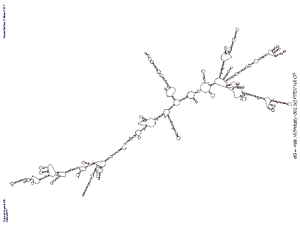
- dsRNA: Most of the described plant viruses have RNA genomes and one of the byproducts of viral replication is double-stranded RNA (dsRNA)5. This dsRNA is very stable and triggers the RNAi pathway. However, even with DNA viruses, some of the genes overlap and can trigger the RNAi pathway too6. With the transgenics that utilized the complete coat protein but triggered the RNAi pathway, it was found that in some cases the secondary structure of the RNA produced regions with dsRNA that could trigger RNA silencing in plants (see image at right)7.
- Short hairpins: The discovery that short dsRNA segments could trigger RNAi led to the use of constructs that generate a hairpin cassette that forms into dsRNA8. Early uses of virus-derived transgenic resistance used entire genes; however, with advances in our understanding of the RNAi pathway, many researchers have adopted the hairpin cassette method as it allows for the targeting of multiple viruses and/or viral genes9. This has several benefits. By targeting multiple genes, researchers are able to minimize the chances of the targeted virus developing resistance to the transgenic plant. The hairpin cassette technique also allows researchers to target multiple viruses with a single construct.
Virus-derived transgenic products on the market
The most widely known transgenic on the market is papaya that is resistant to PRSV10. This product actually saved the papaya industry in Hawaii as PRSV makes fruit unmarketable and eventually kills infected trees. Complicating matters, PRSV is transmitted by several aphids non-persistently (it’s carried in the stylet of the aphid) so it transmits as soon as the aphid probes the plant tissue. Because of this, attempts to control the aphid vectors by spraying does not work as the virus has already been transmitted by the time the aphids are killed.
Resistance to the virus was the only option; however, although resistance to PRSV has been identified in wild relatives, all attempts to introgress the trait were have not been successful introduced into cultivated papaya from a wild relative until just recently11 after 50 years of attempts by plant breeders. The only strategy that papaya growers could use was moving their operations to another island. Each time they moved, there was a short reprieve, but the virus eventually made it to that area. To combat this, work was started to investigate the potential for cross protection; however, it was not effective with the isolates found in Hawaii. Luckily at around that time, news of a new technique was announced that used a transgenic with the coat protein of a virus that provided resistance to that virus. So work on a transgenic began. By the time PRSV made it to the last papaya growing area in Puna, Hawaii, the transgenic was ready and the industry was saved.
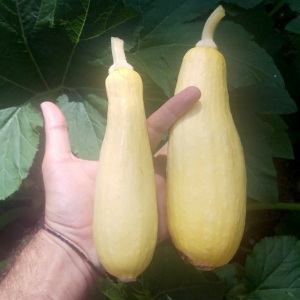
There are two different transgenic events for virus resistance in summer squash. The first, ZW-2012, targets ZYMV and WMV whereas the second, CZW-313, targets CMV in addition to ZYMV and WMV. ZYMV and WMV are related to PRSV (they are all in the same genus, Potyvirus) and are targeted by introduction of the entire coat protein gene that induces the RNAi pathway in plants. The way that the CMV construct works is interesting. It seems that the introduction of the coat protein gene acts by interfering with the life cycle of the virus and by inducing the RNAi pathway.
Virus-derived transgenic products in development
There are a number of transgenic crops that utilize virus-derived resistance currently in development. These range from rice plants engineered to resist Rice grassy stunt tenuivirus14 to cotton plants that are resistant to Cotton leaf curl Kokhran begomovirus15 to tomatoes resistant to Tomato yellow leaf curl begomovirus16 to lettuce that is resistant to Mirafiori lettuce big-vein ophiovirus17. (See here for an article on Biofortified about virus-resistant black beans in Brazil.) Each of these viruses causes severe losses in their respective crops and durable resistance either has not been found or has been hard to introduce into the respective crop plants. This is just a small subset of the virus-derived transgenic plants that are in various stages of development worldwide. However, there are several viral diseases that cause food insecurity and/or severe economic losses that have transgenic solutions. Two that are threats to food security will be discussed below:
Cassava mosaic disease (CMD)
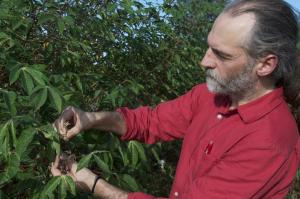
This disease contributes to food insecurity in Africa and Southern Asia18 and is caused by at least 10 related virus species in the genus Begomovirus. Losses to CMD are due to the absence of tubers on infected plants. Since cassava grows well in poor soil with less rain than other staple crops, it is widely grown in sub-Saharan Africa. Because of the severity of the losses and because cassava is often a crop counted on to help reduce the effects of famine, it is an ideal target for virus-derived transgenic resistance.
By targeting a gene that is essential for begomovirus replication (AC1), researchers were able to generate cassava plants that were resistant19 to African cassava mosaic begomovirus as well as two related cassava begomoviruses. This was then improved further by targeting two additional genes essential for begomovirus replication (AC2 and AC3)20. The effort to develop virus-derived transgenic resistance to CMD has been included in the VIRCA Plus project which combines resistance to CMD, cassava brown streak disease and nutritional improvements (transgenic fortification with zinc and iron) with to cassava.
Cassava brown streak disease (CBSD)
Like CMD, CBSD is a threat to food security. Although CBSD can reduce tuber size it does not result in no tubers as with CMD. However, what remains of CBSD symptomatic tubers are inedible due to necrosis in the tubers making infected crops a near total loss21. CBSD is caused by viruses that are transmitted by whiteflies. However, there are only two known species, Cassava brown streak ipomovirus and Ugandan cassava brown streak ipomovirus, and both are generally just referred to as CBSV. Like CMD, the viruses that cause CSBD have been targeted using virus-derived transgenic resistance22 and as mentioned above, transgenic resistance to these viruses have been included in the VIRCA Plus project.
Other avenues for using RNA silencing
The usefulness of RNA silencing is not limited to resistance to plant viruses. There have been other examples of this technology being used to prevent browning due to oxidation (Arctic apple and the Simplot Innate potatoes – see articles on Biofortified about the apple and potato) and reducing acrylamide formation in cooked potatoes (also the Innate potato). Another area being explored that relates to transgenic virus resistance is the development of RNA silencing for arthropod vectors of plant viruses. This is still in the early stages of development, but shows great promise in offering more options for farmers to use in integrated pest management. As with virus-derived resistance, RNA silencing for insect control has focused on turning off genes that are essential for the insect to live, such as v-ATPase subunit A in whiteflies23, or genes that are essential for insect-plant interactions, such as C002 which is expressed in the salivary glands of aphids24. There will be an additional post discussing the use of RNA silencing for other uses in the near future.
Conclusions
Virus-derived transgenic resistance holds great promise in sparing growers and consumers the costs of losses due to virus infection. Furthermore, this technology has saved at least one crop, papaya grown in Hawaii, and holds the potential to grant those in developing nations food security by preventing losses in staple crops. Some of the other benefits of this approach to controlling plant viruses is that it reduces sprays that were used to control the arthropod vectors, while not altering how the crops are grown. One of the main challenges is that resistance to one strain of virus may not give strong resistance to other strains, so the evolution of new virus strains must be closely monitored.
References:
- Leitner et al., 2015. Arthropod Vectors and Disease Transmission: Translational Aspects. PLoS Neglected Tropical Pathogens 9(11): e0004107. DOI: 10.1371/journal.pntd.0004107
- Whitfield et al., 2015. Insect vector-mediated transmission of plant viruses. Virology Volumes 479–480: 278–289 DOI: 10.1016/j.virol.2015.03.026
- Beachy, 1999. Coat-protein-mediated resistance to tobacco mosaic virus: discovery mechanisms and exploitation. Philos Trans R Soc Lond B Biol Sci 354:659-664. DOI: 10.1098/rstb.1999.0418
- Obbard et al., 2009. The evolution of RNAi as a defence against viruses and transposable elements. Philos Trans R Soc Lond B Biol Sci 364(1513): 99–115. DOI: 10.1098/rstb.2008.0168
- Weber et al., 2006. Double-Stranded RNA Is Produced by Positive-Strand RNA Viruses and DNA Viruses but Not in Detectable Amounts by Negative-Strand RNA Viruses. Journal of Virology. 80(10): 5059–5064. DOI: 10.1128/JVI.80.10.5059-5064.2006
- Li et al., 2014. Suppression of RNA Silencing by a Plant DNA Virus Satellite Requires a Host Calmodulin-Like Protein to Repress RDR6 Expression. PLoS One. DOI: 10.1371/journal.ppat.1003921
- Lindbo and Falk, 2017. The Impact of “Coat Protein-Mediated Virus Resistance” in Applied Plant Pathology and Basic Research. Phytopathology 107(6): 624-634 DOI: 10.1094/PHYTO-12-16-0442-RVW
- Jia et al., 2007. A strategy for constructing and verifying short hairpin RNA expression vectors. J RNAi Gene Silencing 3(1): 248–253. PMCID: PMC2737214
- Lambeth et al., 2010. A direct comparison of strategies for combinatorial RNA interference. BMC Molecular Biology 11:77. DOI: 10.1186/1471-2199-11-77
- Gonsalves et al., 2004. Transgenic Virus Resistant Papaya: From Hope to Reality for Controlling Papaya Ringspot Virus in Hawaii. APSnet Features. Online. DOI: 10.1094/APSnetFeature-2004-0704
- Siar et al., 2011. Papaya ringspot virus resistance in Carica papaya via introgression from Vasconcellea quercifolia. Euphytica 181: 159-168 DOI: 10.1007/s10681-011-0388-z
- Fuchs and Gonsalves, 1995. Resistance of Transgenic Hybrid Squash ZW-20 Expressing the Coat Protein Genes of Zucchini Yellow Mosaic Virus and Watermelon Mosaic Virus 2 to Mixed Infections by Both Potyviruses. Nature Biotechnology 13: 1466 – 1473 DOI: 10.1038/nbt1295-1466
- Tricoll et al., 1995. Field Evaluation of Transgenic Squash Containing Single or Multiple Virus Coat Protein Gene Constructs for Resistance to Cucumber Mosaic Virus, Watermelon Mosaic Virus 2, and Zucchini Yellow Mosaic Virus. Nature Biotechnology 13: 1458 – 1465 DOI: 10.1038/nbt1295-1458
- Shimizu et al., 2013. Strong Resistance Against Rice grassy stunt virus Is Induced in Transgenic Rice Plants Expressing Double-Stranded RNA of the Viral Genes for Nucleocapsid or Movement Proteins as Targets for RNA Interference. Phytopathology 103: 513-519 DOI: 10.1094/PHYTO-07-12-0165-R
- Yasmeen et al., 2016. Amplicon-Based RNA Interference Targeting V2 Gene of Cotton Leaf Curl Kokhran Virus-Burewala Strain Can Provide Resistance in Transgenic Cotton Plants. Molecular Biotechnology 58: 807-820 DOI: 10.1007/s12033-016-9980-8
- Fuentes et al., 2016. Field Trial and Molecular Characterization of RNAi-Transgenic Tomato Plants That Exhibit Resistance to Tomato Yellow Leaf Curl Geminivirus. Molecular Plant-Microbe Interactions 29: 197-209 DOI: 10.1094/MPMI-08-15-0181-R
- Kawazu et al., 2016. Development of marker-free transgenic lettuce resistant to Mirafiori lettuce big-vein virus. Transgenic Research 25: 711-719 DOI: 10.1007/s11248-016-9956-2
- Alabi et al., 2011. Cassava Mosaic Disease: A Curse to Food Security in Sub-Saharan Africa. APSnet Features. Online. DOI: 10.1094/APSnetFeature-2011-0701
- Chellappan et al., 2004. Broad Spectrum Resistance to ssDNA Viruses Associated with Transgene-Induced Gene Silencing in Cassava. Plant Molecular Biology 56: 601-611 DOI: 10.1007/s11103-004-0147-9
- Zhang et al., 2005. Resistance to cassava mosaic disease in transgenic cassava expressing antisense RNAs targeting virus replication genes. Plant Biotechnology Journal 3: 385-397 DOI: 10.1111/j.1467-7652.2005.00132.x
- Patil et al., 2015. Cassava brown streak disease: a threat to food security in Africa. Journal of General Virology 96: 956-968 DOI: 10.1099/vir.0.000014
- Ogwok et al., 2012. Transgenic RNA interference (RNAi)-derived field resistance to cassava brown streak disease. Molecular Plant Pathology 13: 1019-1031 DOI: 10.1111/j.1364-3703.2012.00812.x
- Thakur et al., 2014. Enhanced Whitefly Resistance in Transgenic Tobacco Plants Expressing Double Stranded RNA of v-ATPase A Gene. PLoS One 9(3): e87235 DOI: 10.1371/journal.pone.0087235
- Pitino et al., 2011. Silencing of Aphid Genes by dsRNA Feeding from Plants. PLoS One 6(10): e25709 DOI: 10.1371/journal.pone.0025709
Written by Guest Expert
Alma Laney works with plant viruses and the arthropods who vector them and on his blog The Mad Virologist he covers all aspects of virology from human pathogens to archaea viruses and everything in between. http://themadvirologist.blogspot.com/
What biotechnology issues resonate with students?
Written by Brittany Anderton
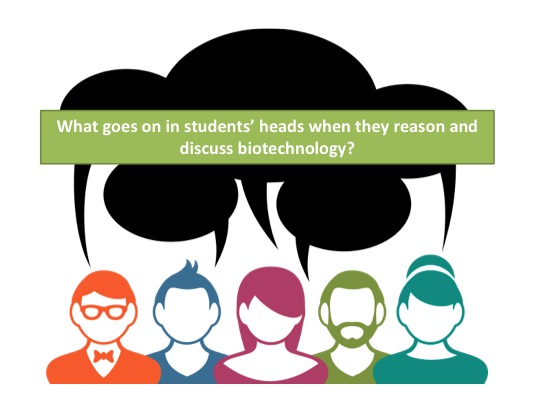
Biotechnology is poised to become one of the most valuable scientific revolutions of the 21st century. Because the field is developing so quickly, the gap between expert and non-expert knowledge is increasing at a time when societal decisions about it are becoming more and more important. So how do we promote biotechnology literacy in the classroom? What should non-experts know about genetic technologies in order to make informed decisions? I conducted a study to answer these questions, and here is what I found.
Even though scientific knowledge is an important part of science literacy, how people feel about a technology – their general positive or negative attitudes – also plays a role in their decision-making. In fact, there’s evidence that attitudes play a greater role than knowledge in determining students’ behavior toward biotechnology. I set out to understand what issues undergraduate students draw upon when they reason about genetic technologies. I also wanted to know whether classroom dialogue about biotechnology influences their attitudes and understanding. This information can provide a window into the conceptual frameworks that students use to make decisions about genetic technologies, and can help educators and communicators develop specific strategies for connecting with their audiences.
Students discuss biotechnology
Twenty years ago, my postdoctoral mentor Pamela Ronald launched an innovative course designed for non-science majors at UC Davis. Genetics and Society engages students in the science, politics, social issues, ethics, and economics surrounding biotechnology. It remains popular today. Recognizing the importance of dialogue around this complex topic, Pam introduced “discussion sections” into the course. During the discussion sections, students engage in rational discourse about a biotechnology issue – for example, whether or not all food containing genetically engineered (GE) ingredients should be labeled as “GMO”. The discussion sections provide an opportunity for students to share their thoughts and consider the many facets involved in decision-making about biotechnology. Scientific arguments used in the class are required to be evidence-based, and students are graded on the credibility of their sources. While students in Genetics and Society generally enjoy these peer-to-peer discussions, no one had looked closely at how they influence their understanding and attitudes about genetic technologies.
At the beginning of the course, I asked the students to state their attitudes on seven different biotechnology applications. Three topics related to food: whether or not we should label GMOs, whether GE of plants should be prohibited, and whether GE of animals should be prohibited. I also asked the students to justify their attitude for each topic. At the end of each weekly discussion section, during which a group of students presented on an individual application/topic, I collected this information a second time from the students in the audience. These pre-post attitudes with corresponding reasoning provided the data for my study.

I started by looking for significant changes in students’ attitudes following the discussion sections. I found significant changes for three topics: GMO labeling, GE of animals, and the FDA ban on 23andme’s health reports* (Figure 1). Because the students did not appear to have familiarity with the 23andme ban at the beginning of the course, I didn’t select that topic for further analysis. In the end, I selected GMO labeling and GE of animals, as well as two topics for which I didn’t observe significant attitude changes (DNA fingerprinting and human embryo editing research) for further analysis. Pam and I reasoned that it was important to take a close look at student reasoning in the presence and absence of attitude changes, because learning can happen even if a person doesn’t change their mind.
Analyzing the themes
Using the justifications given by the students for their attitudes on the four topics selected above – GMO labeling, GE of animals, DNA fingerprinting and human embryo editing – I performed an approach called thematic analysis, in which I looked for overarching patterns or themes that were prevalent in students’ reasoning about biotechnology. Through an iterative process, I identified seven major themes that students drew upon in their justifications (Figure 2). I also tallied the number of times I detected a change in the use of a theme following a given discussion section (i.e., whenever a student adopted new reasoning or abandoned prior reasoning following a discussion section).
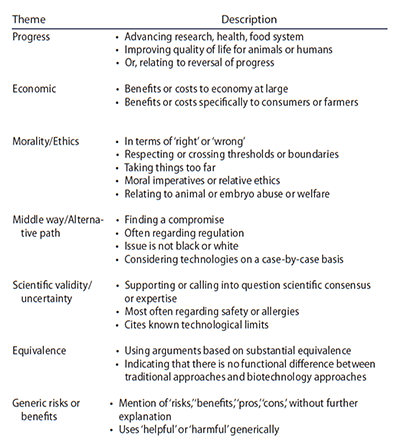
Our preliminary evidence suggests that the discussion sections – and perhaps classroom discourse in particular – provide students with a more nuanced understanding of biotechnology. For example, students generally increased their use of “Middle Way” reasoning following the discussion sections. This suggests that they developed a greater appreciation of regulations that consider biotechnology applications on a case-by-case basis. We also observed increased use of the Economic theme following the two discussion sections for which students had significant attitude changes. It is possible that the economic considerations of genetic technologies can sway people’s attitudes, but this remains to be proven.
Scientific decision-making involves more than just facts. By better understanding the complex processes that take place when students learn and make decisions about genetic technologies – like we did in this study – educators can connect with their audiences and promote biotechnology literacy. A more informed and nuanced discussion will help our society determine the best ways to use biotechnology and to direct our focus as it continues to evolve.
To access the full version of the manuscript, Hybrid thematic analysis reveals themes for assessing student understanding of biotechnology, please go to: http://dx.doi.org/10.1080/00219266.2017.1338599.
Please address any questions or comments to Brittany Anderton at bnanderton@udavis.edu.
*The FDA banned 23andme genetic health reports in November 2013, citing concerns about the accuracy and usefulness of such information to consumers. In October 2015 the ban was lifted, and 23andme resumed offering carrier-status testing, though no longer offers testing for health conditions such as cancer and heart disease.
Written by Guest Expert
Brittany Anderton seeks to improve the intersection of science and society by educating the next generation of responsible scientists and citizens. She has a PhD in cancer biology, studied the teaching and communication of biotechnology as a postdoctoral fellow at UC Davis, and is now the Associate Director of Research Talks at iBiology and Lecturer at CSU Sacramento.
March for Science with Biology Fortified!
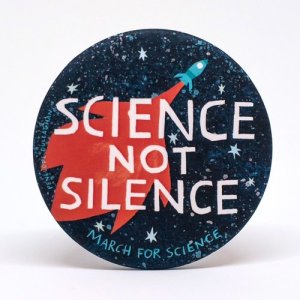
Tomorrow, thousands of people across the United States and even the world will March for Science. As both a celebration of knowledge and discovery and as a protest against political interference and rejection of scientific facts, the March for Science has gathered tremendous energy and enthusiasm, with over 600 cities hosting satellite marches. Biology Fortified is one of many partners of the march, and we encourage our readers and followers – if you haven’t already – to make plans to be a part of this historic march either in-person or online!
I’m going to inform you about local events where we are participating, and finally, explain what I think is important for us to march about, which I hope you will be compelled to agree with. Finally, if you want to help us out we have flyers that can be printed and distributed.
Biology Fortified and the March for Science
Join us at these local events!
Washington DC: 10 am Tent 7, Anastasia Bodnar will give a teach-in about GMOs called “Plants with Superpowers”. The talk is already “sold out” but there may be space so show up!
San Francisco, CA: 3:30-4 pm, “The Scientist is in” Table, Civic Center Plaza, Karl Haro von Mogel will give a demonstration of non-browning potatoes, answer questions about biotechnology, and Guido Núñez-Mujica from the Alliance for Science will show you how you can extract DNA from a strawberry! Karl will announce his demonstration on the Open Mic during a brief speech about non-partisanship in science.
Chicago, IL: 12-3 pm Science Expo in front of the Field Museum, David Sutherland will host an energetic table with information about science and activism.
Madison, WI: 2:30-2:45 pm UW Science Hall/Library Mall, Kavin Senapathy will talk about how “Science Unites”.
More March for Science events of interest!
San Francisco, CA: 11 am Justice Herman Plaza, Pam Ronald, UC Davis Professor and former BFI board member will give one of the main talks at the rally!
Atlanta, GA: Between 12-4 pm, Alison Bernstein will give one of their keynote speeches.
Honolulu, HI: Between 3-7 pm, Joni Kamiya will give a speech about the need for curiosity and problem-solving.
Kansas City, MS: Between 10 am-2 pm, SciBabe Yvette d’Entremont will give a speech at the local MfS rally.
Dallas, TX: Dallas Fair Park, 1:15 pm, FOOD EVOLUTION screening!
Any more to highlight? let us know in the comments!
Printable Flyers
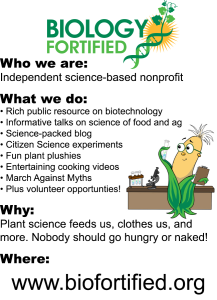 At some of our events, where permitted, we will be passing out flyers. If you want to print and bring some of these to tell people about the work that Biology Fortified does, and our upcoming March Against Myths on May 20, feel free to print them out!
At some of our events, where permitted, we will be passing out flyers. If you want to print and bring some of these to tell people about the work that Biology Fortified does, and our upcoming March Against Myths on May 20, feel free to print them out!
BFI Flyer (4 per page, color)
BFI/MAMyths flyer (4 per page, color, print front/back for two sided flyers)
BFI/MAMyths flyer (4 per page, B/W, print front/back for two sided flyers)
After the March
Biology Fortified will be hosting two webinars after the march, focused on getting started in science communication, and a primer on genetically engineered plants. As part of the “Science Communicates” and “Science Creates” days of action of the March for Science, these open webinars will also be available to re-view after the broadcast times. Check back on these pages for the link to the broadcast events!
Wednesday 4/26 12:30 pm Pacific (3:30 pm Eastern): Start Talking about Science Today, with Kevin Folta and Karl Haro von Mogel
Thursday 4/27 12:00 pm Pacific (3:00 Eastern): Plants with Superpowers, with Karl Haro von Mogel
Watch and listen with an open mind, and come with your questions!
Why I March for Science
I have long been an advocate for science, since my early days in college at UC Davis, when I convinced the school paper, The California Aggie, to let me write a science column – something they never did before. I was spurred into action because of my desire to write and communicate science, and because of unscientific nonsense communicated by a political columnist about global warming. Since then I have spent thousands of volunteer hours writing, hosting a radio show, creating videos, attending conferences, giving talks, conducting interviews, generating public resources, and two years ago I co-founded a movement to take science to the streets to fight myths about biotechnology and more.
One of the main problems I see with the intersection of politics and science is that people from different political parties and walks of life tend to selectively accept and support areas of science that they already agree with, or that have implications that are in line with their personal philosophies. They then reject and sometimes even deny the science when it runs contrary to those values. Conservatives tend to reject climate change, the use of embryonic stem cells, and the theory of evolution. Liberals tend to reject vaccine safety, the safety and use of genetic engineering in agriculture, and medical science – preferring “alternative medicine” instead.
I reject all of these rejections. I live in a real Universe, with observable and testable natural laws, and we have invented a wonderful method called The Scientific Method, that compels us to accept conclusions that are built up from accumulated evidence, experimentation, and logic. To accept science in one field but reject it when convenient in another means that you reject part of reality, and that can be dangerous. The key is recognizing that our shared reality is the same no matter who we are, but it is our values that differ and we should not confuse these values with science.
The March for Science started as a push-back to the actions of a member of one political party, but they have made great efforts to promote a plurality of science and this is something that I can get behind. Join me – join us – near or far, in marching for science – all of it!
